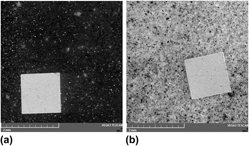Published online by Cambridge University Press: 30 September 2014

Yttrium–aluminum garnet doped with Ce was plasma sprayed using two different processes – gas-stabilized plasma torch and water-stabilized plasma torch. Coatings on various substrate materials (stainless steel, ceramics, YAG undoped crystals), as well as self-standing plates, were obtained. The coatings adhered on materials with relatively large variety of thermal expansion coefficient. Besides microstructural, crystallographic, and thermal-stability investigations, numerous optical tests were performed. They included cathodoluminescence (CL), UV-VIS-NIR reflectance, and response of the Ce:YAG on light with various wave lengths. After spraying, the desired YAG crystalline phase sustained without any decomposition, but an amorphous fraction was present in both types of coatings. Selected coatings were heat-treated to crystallize fully and change their optical properties. Minor amorphous fraction crystallized at 930 °C. The heat-treated coatings exhibited higher CL and also larger visible emission when illuminated with a 366 nm lamp. Microhardness of the coatings was tested as well and proved the mechanical similarity of both coating types and difference from the single crystal. The optical responses of the coatings were influenced by imperfections like splat boundaries, pores, and thin cracks, which were healed only partly by heat treatment. However, the Ce:YAG was first plasma sprayed and moreover produced by both spray techniques without an irreversible loss of the desired garnet phase.